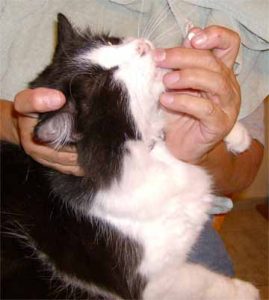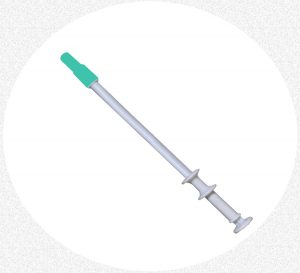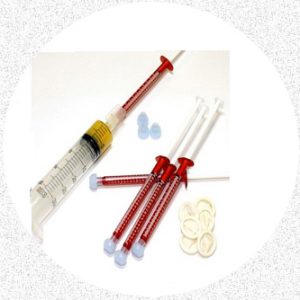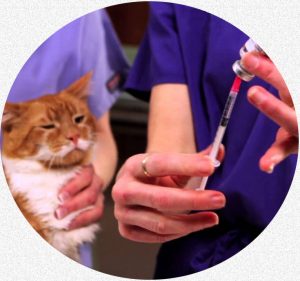Ron Hines DVM PhD
It has to do with a number of things. Most of them are the ways all felines – big and small – developed in Nature. At one long-ago time, cats and dogs split off from the same animal (about 43 million years ago) It was a medium-size animal that looked somewhat like the fossa in this photo  Fossas exist to this day in Madagascar. Being somewhere between a cat and a dog, they are susceptible to the diseases of both and so, in zoos they receive their cat, as well as their dog vaccinations. You can read more about these strange creature’s here if it interests you.
Fossas exist to this day in Madagascar. Being somewhere between a cat and a dog, they are susceptible to the diseases of both and so, in zoos they receive their cat, as well as their dog vaccinations. You can read more about these strange creature’s here if it interests you.
When dogs and cats parted ways, cats went on to become more specialized meat eaters than dogs. Their faces became shorter than dogs because most of them caught their prey by ambush and a sudden pounce. Canines, on the other hand, ran their prey down, nipping at them as they ran. The wolf and fox lines that became dogs preferred meat. But to this day, they are not above eating fruits and plants when prey is scarce. They passed that tendency on to dogs. For cats, on the other hand, its generally meat or nothing. (read here)
Since cats no longer required taste buds that recognized sweet, they lost the ability to sense sweet taste. That same author told me that he was quite surprised to find that a cat’s abilities to detect bitter was so highly developed in a species that, in nature, never eats plants. Scientists do not know why but some have theories. The fact that the gall bladders of their prey contain bile that is quite bitter and can also be toxic might have something to do with it as well.
The ability to sense bitter is a two way street, it protects animals that eat plants from consuming plants that are toxic and it allows certain plants (often toxic ones) to let animals know that they prefer not to be eaten. Cats also have very complex amino acid (umami/Tas1r1) taste receptors, which might also be involved in their violent distaste for medications. They also have very sensitive “mouth feel” – a quick response as to whether things in their mouth need to be swallowed or spit out. Cats also have a functioning taste/smell structure on the roof of their mouth, their Jacobson’s organ.
Another problems is that the cat’s rough, prickly tongue holds distasteful flavors in their mouth longer, causing them to foam and wretch in an attempt to rid themselves of the horrible taste. Their relatively short face and ability to pulse their tongues to move tablets away from the back of the throat and sharp claws makes administration even more of a challenge.
The time cats and dogs have had to adapt to human companionship is also very very different and contributes a lot to the their different responses to medication. Dogs have lived with humans for about 41,000 years. That gave dogs a lot of time to become obliging and to sensing what we wish them to do. The domestication of cats took place much more recently (the Middle Ages). So our cats still retain much of their wild kitty-like demeanor. In only a few, very obliging cats, does that demeanor include taking behavior clues from their owners when it comes to what they eat. Most cats do not, by nature, cooperate or aim to please. That is because they do not come from herd/pack animal stock.
Also, by nature, dogs are gulpers – once something is perceived as food its gulped down, not savored. A food’s aroma seems to be the major cue to eat or not eat something in dogs. Cats are considerably more delicate, choosy and discriminating eaters.
That long explanation of mine is why it is can be next to impossible to get your cat to take oral medications. Its rooted in their genetics – both a psychological problem in the way their brain is wired and a physical problem due to their tasting structure. Perhaps you can find solace in that.
Unfortunately, many medications veterinarians need to give to your cat are quite bitter. Antibiotics, methimazole (Tapazol®), furosemide (Lasix®) and the alkaloids that comprise many medications are all extremely bitter. If the tablet form is well coated and the proper size for your cat, you might get by giving it orally. But if it must be split, your cat is going to complain about the taste. Pediatric syrups use sweet to mask bitter. But as you know, cats can’t taste sweet. We humans face the same bitter medicine problem, but our mind overrules our basic nature to avoid the bitter or astringent. That is why children, not old enough to understand, fight taking medicines the most.
So What Are My Options?
Pills?
Generic medications are the least expensive. They might be the ones your veterinarian prescribes. They are sized for the body weight of humans and before giving the proper portion to a cat, they must be split, exposing their bitter interior. But when the medicine is produced specifically for small dogs or cats, it is probably film coated, already the right size and much easier to administer. Your pharmacy might offer to grind a tablet medication, turn it into a liquid and add flavoring agents. Most of those agents were designed to mask bitter flavors when given to humans – not cats. Mixing the ground up medications with flavors like bubblegum or peanut butter is a waste of time. Perhaps a masking agent such as tuna, salmon, sardine or bacon would help – but I do not believe they are commercially available. If done at home, one must be sure that the added ingredients do not alter the absorption or characteristics of the medication. In any case, it is my experience that most cats will reject foods that have the slightest hint of drug flavor hidden within them. You can often tell by your cat’s body language if it will likely eat something set in front of it.
Purchase a pill gun?
If you have to give pills to your cat purchase a simple pill gun. Have someone show you how to use it correctly. Place the pill as far back in your cat’s mouth as you can (mouth, not throat) and hold his mouth closed after the pill is inserted. The cat needs to be bundles up in a large towel so it does not scratch you. I squat and place them between my folded knees. But it is easier as a two-person operation. Follow all pills with a liberal squirt of water. Once a cat licks its nose, it has swallowed the pill. Confine you cat to a cat carrier for ten minutes after giving the medicine – to be sure it was not spit out.
Transdermal Formulas?
Many medications that cats commonly need can be prepared (compounded) as a transdermal gel or cream that penetrates into the blood stream when applied to the inner surface of the cat’s ear. When the drugs that these medications contain were approved by the FDA, the medications were given orally or by injections. I know of none where transdermal studies were performed other than fentanyl patches. But the FDA allows these custom-created gel medications to be sold. Regulation is minimal. Few scientific studies have been done to confirm how much of the active drug gets into the cat’s system. Compounding pharmacies differ in their compounding techniques. Individual cats differ in the amount of drug they absorb. Owner techniques in applying the gels also differ and influence the amount of drug that is absorbed. But despite these limitations, custom-produces transdermally formulated medicines might be the best option for your cat. I generally suggest an owner or the animal hospital give the oral form for a week or two to see its effect and then gives you a prescription for the same medication in transdermal form. Once switched, the cat needs to be followed to see if the same desired results are obtained with the transdermal product. You can find many companies online that will produce transdermal medications in response to your veterinarian’s called-in or written prescription.
Injections?
Most cats object to oral medications considerably more than they object to injections. Ask your veterinarian or pharmacist if the medicine you cat needs comes in injectable form. A lot of cat owners are uncomfortable about giving their pet shots. But with time, most cat owners loose that discomfort. Let the veterinary technicians show you how it is done. The key to success is adequate restraint. Never try to give cats injections without a second person present who is comfortable with the procedure. You do not want to be scratched. You do not want to be bitten. What appears to you to be a bit too restraining a technique in preventing movement is probable just right. There are videos on YouTube that show you how it is properly done; but videos are no substitute for hands on instruction by one of your veterinarian’s technicians.
This Is The Pilling Technique That Works Best For Me:
1) Clip your cat’s sharp claws with a human toenail clipper or have your vet tech or groomer do it. If you are not experienced at doing it, it is best left to others who have that experience. After the nails are cut, I smooth them with an emery board. Cutting nails too short is painful to your cat. Cat scratches to you are not only painful, they can transmit a number of diseases you do not want to be exposed to. So can cat bites.
2) Get everything ready. Seal off nooks, crannies and escape routs. Your cat knows what’s up. Turn on the lights. Open the pill container. Get some bath towels. Find a pencil with a good portion of the eraser left on it. Pour a small cup of water and place everything on a low table along with some facial tissues. Put some antibacterial soap next to the sink to clean your hands afterwards and some povone iodine solution for you if you get scratched.
3) Coat the pill well with butter. Dry pills can get stuck in your cat’s throat. If you must break a pill, try to break it into pieces with no sharp corners. The pieces do not have to be exactly the same size as long as the total day’s dose is what was recommended by your veterinarian. Place your cat between your knees in a towel or cloth so it cannot wiggle or scratch you. Get the assistance of another person if you can. Wrap the cat so that only its head is exposed. Let the cat calm down. Stroke it and talk to it softly. Then, tilt the cat’s head back until it is looking at the ceiling. It should open its mouth slightly at this point. Pry open its mouth with your thumb and forefinger placed under its upper lips just behind its upper fangs. Drop the pill as far back into the mouth as possible. The hump to the rear of your cat’s tongue marks the point from which there are no more taste buds. Drop the pill into its mouth as far back as possible so that it lands behind that hump or push it there with the pencil eraser and immediately hold the pet’s mouth closed so that it cannot spit the tablet out. Place a drop of water on its nose with your free hand and continue to hold the mouth closed until it licks it nose. Once it has licked its nose, it has swallowed the pill. Then wipe any foam and saliva off of the cats face and mouth.
4) Fill the 3 ml syringe with flavored broth and in half ml increments, place the liquid in your cat’s mouth being sure it is swallowed. Do not tilt the cat’s head back when giving liquids. The fluid is to prevent the medication from lodging in the pet’s throat.
5) Stroke and praise your cat, offer it a treat. Tell it how wonderful it behaved.
That technique has worked well for me over the many years I have been privileged to be a veterinarian. Over that same long period, I have been bitten by frightened or angry cats innumerable times. There is a good chance that you will be bitten too. If that risk worries you or if you yourself have health issues, please do not attempt to give pills or oral medications to your cat.
Hide The Medicine In Food?
Cats are quite good at not taking medicine when it is hidden in food. It has never worked for me. But there are several things that might help you do it successfully:
1) Your cat needs to be quite hungry when you attempt to hide medicine in its food.
2) You need to crush the tablet into a fine powder.
3) You need to use a very pungent food to mask the bad taste. Anchovies, sardines, liverwurst, gourmet canned cat food, tuna paste and Underwood’s deviled ham are good choices unless you know another flavor your cat really loves. Warm the food up. Give the cat a small dab of it unmedicated first.
4) Begin with a very very small amount of the bad tasting medicine – even if it is much lower than the dose that was suggested – and gradually increase the amount in succeeding attempts as your cat becomes accustomed to the taste. This will mean that for a while, you will be giving the smaller dose more frequently during the day.
Turning The Tablet Into A Liquid And Giving It Orally With A Syringe?
Liquefy one of the pungent-tasting foods I mentioned in a blender. Crush the medicine into a powder or let it dissolve in a tablespoon full of water. Mix the two together. Test that the mix passes easily and smoothly through a 3 ml disposable syringe that has the needle removed. If it does not, the food needs to be blended longer or the pill needs to be crushed finer. If it still will not flow easily, ream out the tip of the 3 ml syringe with a 1/8-inch drill bit held by a vice-grip™. Again, do not attempt to give the first doses at the full prescribed dose. Talk to you veterinarian and ask if you can simply give more smaller doses during the day. Your vet will probably consent to that.
Trick Your Cat?
Most cats cannot stand being dirty. They will lick off most any liquid or paste placed on their paws and wrists. Try that with a meat paste or pate you prepare with the crushed medication. Make it fresh because there is no telling how long the medication will keep its strength when mixed with food. Keep your cat restricted to a small area until it licks its paws clean or it will mess up the house.
Syrups And Liquids Designed For Children?
The industry standard in masking objectionable tasting liquid medications is to add a strong fruit and sugary flavoring. These are called pediatric syrups. Cherry is simulated by adding benzaldehyde, black cherry by adding acetophenone, grape with anthranilate and banana with isoamyl acetate. Cats hate all these tastes. If you squirt these liquids forward in their mouth, the cat will foam and gag. If you squirt them far enough back, the cat may inhale them into its lungs. I do not recommend human pediatric syrups for cats.
Foaming Cats
The usual cause of foaming is placing the medication too far forward in your cat’s mouth or having small grains of the powdered medicine on your fingers or on the pill gun. Foaming looks terrible but it is not dangerous or painful. Just wipe the excess foam off.
You are on the Vetspace animal health website
Visiting the products that you see displayed on this website help pay the cost of keeping these articles on the Internet.





